Nursing Reflective Essay: Mental Health Care and Johns' Model
VerifiedAdded on 2021/06/17
|9
|2614
|487
Essay
AI Summary
This reflective essay delves into the complexities of mental health care, employing Johns' model of reflection to analyze a clinical scenario involving a patient with psychosis. The essay explores the internal and external factors influencing the author's perspective, drawing on the video of Charles and his family to understand the impact of mental illness on patients and their caregivers. It examines the challenges in identifying and treating psychosis, emphasizing the importance of education and the need for healthcare professionals to develop empathy, active listening, and effective communication skills. The essay also discusses the ethical and scientific aspects of mental health care, including the differences between delirium and schizophrenia, and the application of the DSM-IV diagnostic criteria. Ultimately, it aims to enhance the author's understanding of patient care and improve their future practice in the field of mental health.
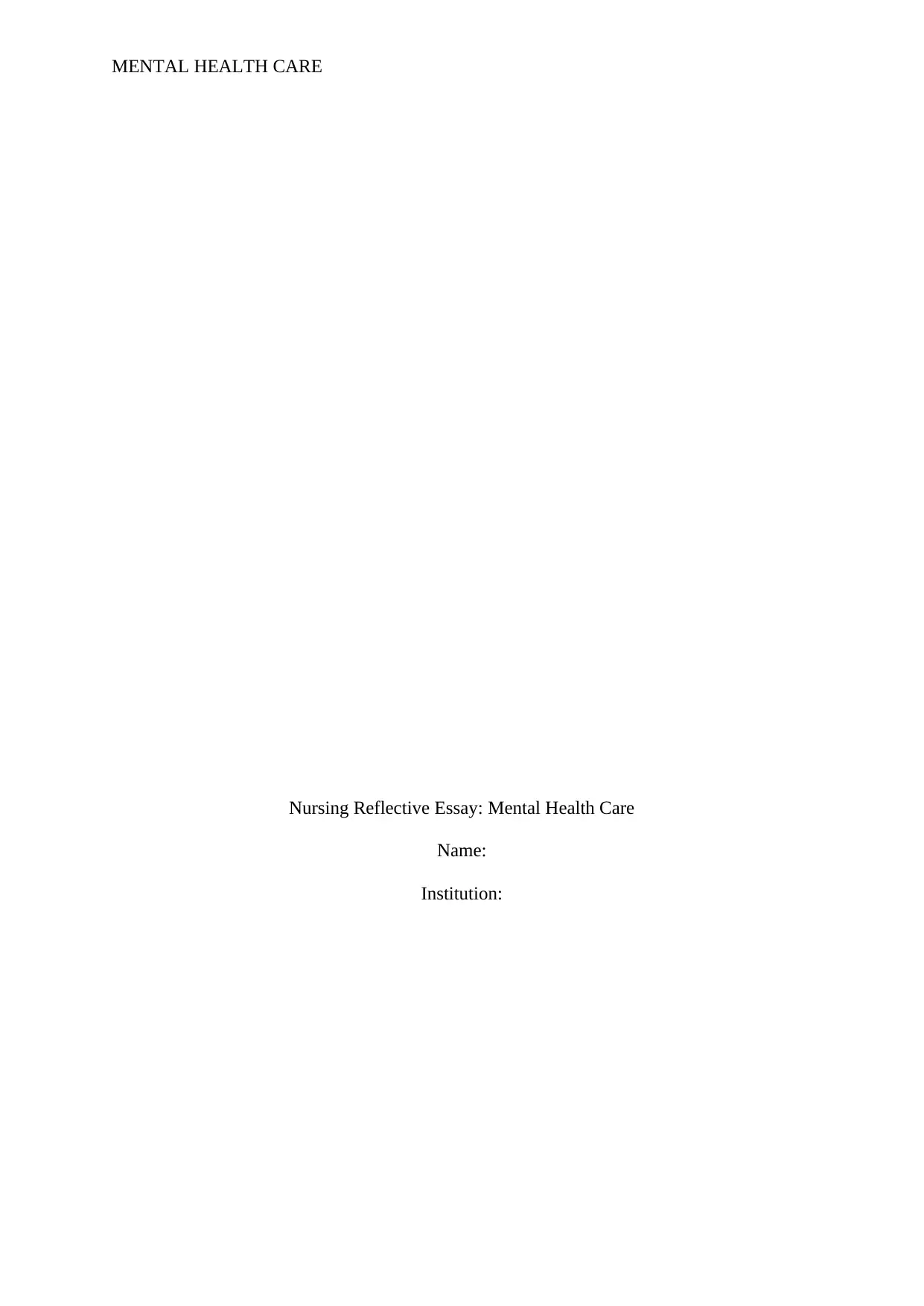
MENTAL HEALTH CARE
Nursing Reflective Essay: Mental Health Care
Name:
Institution:
Nursing Reflective Essay: Mental Health Care
Name:
Institution:
Paraphrase This Document
Need a fresh take? Get an instant paraphrase of this document with our AI Paraphraser
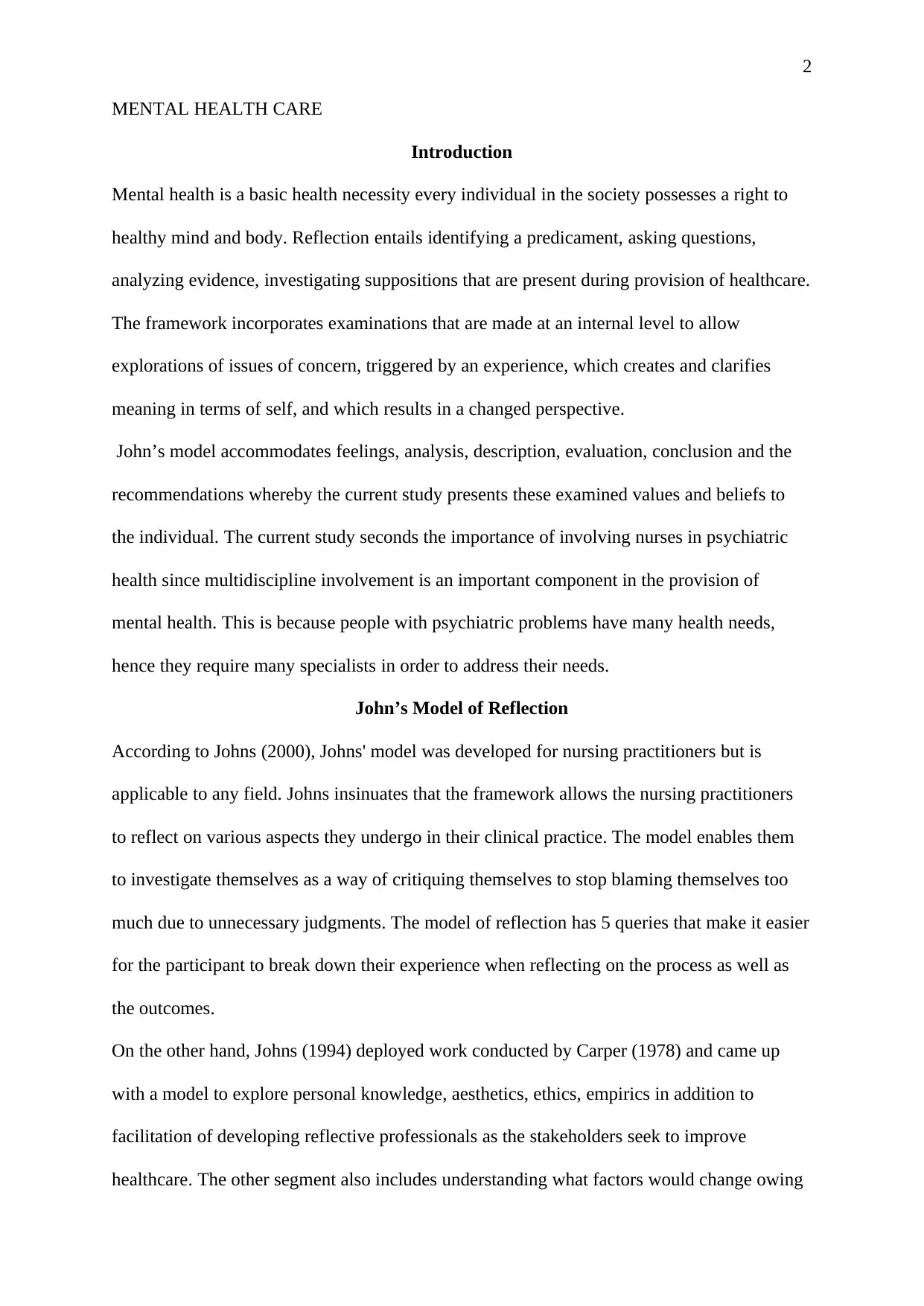
2
MENTAL HEALTH CARE
Introduction
Mental health is a basic health necessity every individual in the society possesses a right to
healthy mind and body. Reflection entails identifying a predicament, asking questions,
analyzing evidence, investigating suppositions that are present during provision of healthcare.
The framework incorporates examinations that are made at an internal level to allow
explorations of issues of concern, triggered by an experience, which creates and clarifies
meaning in terms of self, and which results in a changed perspective.
John’s model accommodates feelings, analysis, description, evaluation, conclusion and the
recommendations whereby the current study presents these examined values and beliefs to
the individual. The current study seconds the importance of involving nurses in psychiatric
health since multidiscipline involvement is an important component in the provision of
mental health. This is because people with psychiatric problems have many health needs,
hence they require many specialists in order to address their needs.
John’s Model of Reflection
According to Johns (2000), Johns' model was developed for nursing practitioners but is
applicable to any field. Johns insinuates that the framework allows the nursing practitioners
to reflect on various aspects they undergo in their clinical practice. The model enables them
to investigate themselves as a way of critiquing themselves to stop blaming themselves too
much due to unnecessary judgments. The model of reflection has 5 queries that make it easier
for the participant to break down their experience when reflecting on the process as well as
the outcomes.
On the other hand, Johns (1994) deployed work conducted by Carper (1978) and came up
with a model to explore personal knowledge, aesthetics, ethics, empirics in addition to
facilitation of developing reflective professionals as the stakeholders seek to improve
healthcare. The other segment also includes understanding what factors would change owing
MENTAL HEALTH CARE
Introduction
Mental health is a basic health necessity every individual in the society possesses a right to
healthy mind and body. Reflection entails identifying a predicament, asking questions,
analyzing evidence, investigating suppositions that are present during provision of healthcare.
The framework incorporates examinations that are made at an internal level to allow
explorations of issues of concern, triggered by an experience, which creates and clarifies
meaning in terms of self, and which results in a changed perspective.
John’s model accommodates feelings, analysis, description, evaluation, conclusion and the
recommendations whereby the current study presents these examined values and beliefs to
the individual. The current study seconds the importance of involving nurses in psychiatric
health since multidiscipline involvement is an important component in the provision of
mental health. This is because people with psychiatric problems have many health needs,
hence they require many specialists in order to address their needs.
John’s Model of Reflection
According to Johns (2000), Johns' model was developed for nursing practitioners but is
applicable to any field. Johns insinuates that the framework allows the nursing practitioners
to reflect on various aspects they undergo in their clinical practice. The model enables them
to investigate themselves as a way of critiquing themselves to stop blaming themselves too
much due to unnecessary judgments. The model of reflection has 5 queries that make it easier
for the participant to break down their experience when reflecting on the process as well as
the outcomes.
On the other hand, Johns (1994) deployed work conducted by Carper (1978) and came up
with a model to explore personal knowledge, aesthetics, ethics, empirics in addition to
facilitation of developing reflective professionals as the stakeholders seek to improve
healthcare. The other segment also includes understanding what factors would change owing
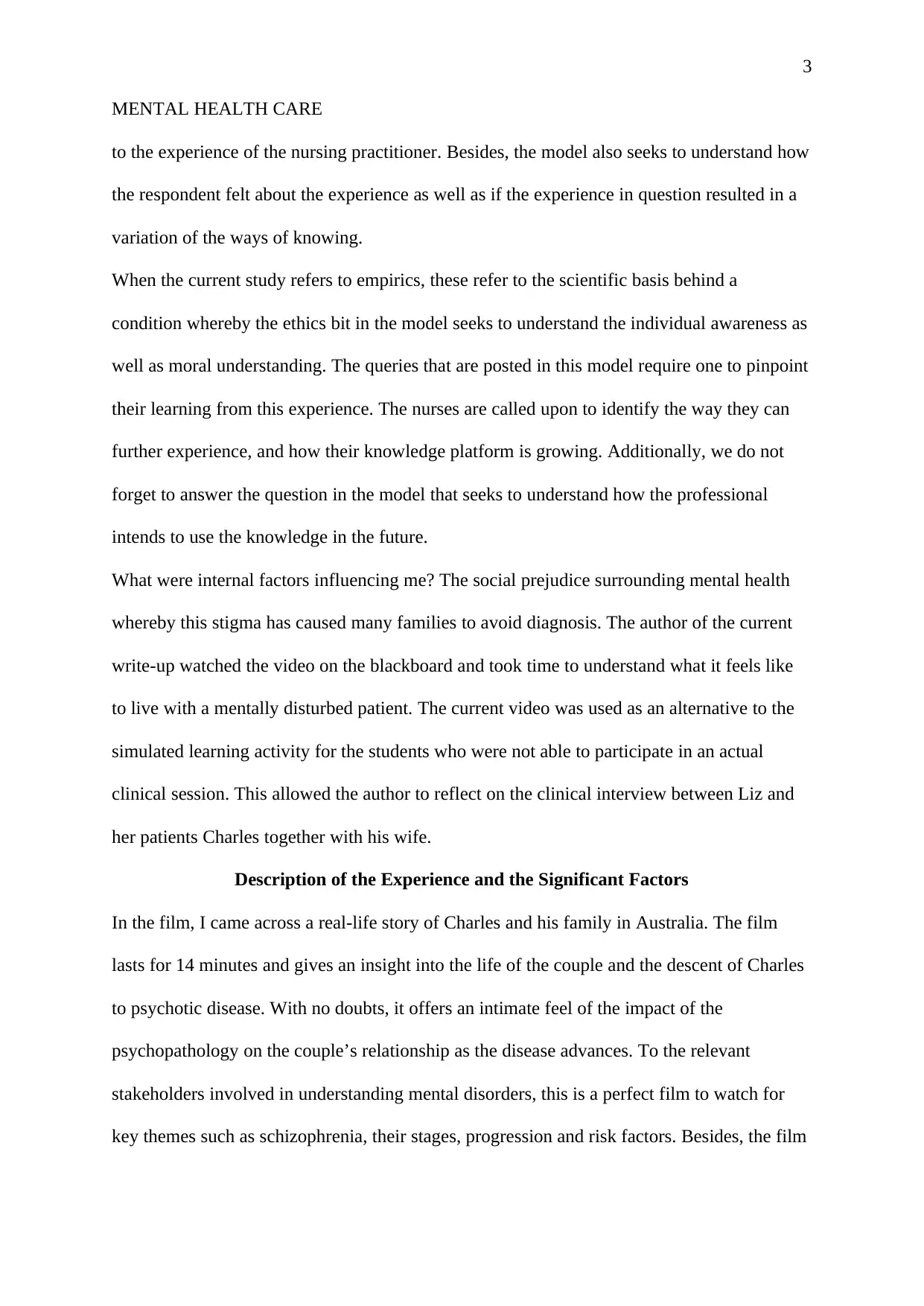
3
MENTAL HEALTH CARE
to the experience of the nursing practitioner. Besides, the model also seeks to understand how
the respondent felt about the experience as well as if the experience in question resulted in a
variation of the ways of knowing.
When the current study refers to empirics, these refer to the scientific basis behind a
condition whereby the ethics bit in the model seeks to understand the individual awareness as
well as moral understanding. The queries that are posted in this model require one to pinpoint
their learning from this experience. The nurses are called upon to identify the way they can
further experience, and how their knowledge platform is growing. Additionally, we do not
forget to answer the question in the model that seeks to understand how the professional
intends to use the knowledge in the future.
What were internal factors influencing me? The social prejudice surrounding mental health
whereby this stigma has caused many families to avoid diagnosis. The author of the current
write-up watched the video on the blackboard and took time to understand what it feels like
to live with a mentally disturbed patient. The current video was used as an alternative to the
simulated learning activity for the students who were not able to participate in an actual
clinical session. This allowed the author to reflect on the clinical interview between Liz and
her patients Charles together with his wife.
Description of the Experience and the Significant Factors
In the film, I came across a real-life story of Charles and his family in Australia. The film
lasts for 14 minutes and gives an insight into the life of the couple and the descent of Charles
to psychotic disease. With no doubts, it offers an intimate feel of the impact of the
psychopathology on the couple’s relationship as the disease advances. To the relevant
stakeholders involved in understanding mental disorders, this is a perfect film to watch for
key themes such as schizophrenia, their stages, progression and risk factors. Besides, the film
MENTAL HEALTH CARE
to the experience of the nursing practitioner. Besides, the model also seeks to understand how
the respondent felt about the experience as well as if the experience in question resulted in a
variation of the ways of knowing.
When the current study refers to empirics, these refer to the scientific basis behind a
condition whereby the ethics bit in the model seeks to understand the individual awareness as
well as moral understanding. The queries that are posted in this model require one to pinpoint
their learning from this experience. The nurses are called upon to identify the way they can
further experience, and how their knowledge platform is growing. Additionally, we do not
forget to answer the question in the model that seeks to understand how the professional
intends to use the knowledge in the future.
What were internal factors influencing me? The social prejudice surrounding mental health
whereby this stigma has caused many families to avoid diagnosis. The author of the current
write-up watched the video on the blackboard and took time to understand what it feels like
to live with a mentally disturbed patient. The current video was used as an alternative to the
simulated learning activity for the students who were not able to participate in an actual
clinical session. This allowed the author to reflect on the clinical interview between Liz and
her patients Charles together with his wife.
Description of the Experience and the Significant Factors
In the film, I came across a real-life story of Charles and his family in Australia. The film
lasts for 14 minutes and gives an insight into the life of the couple and the descent of Charles
to psychotic disease. With no doubts, it offers an intimate feel of the impact of the
psychopathology on the couple’s relationship as the disease advances. To the relevant
stakeholders involved in understanding mental disorders, this is a perfect film to watch for
key themes such as schizophrenia, their stages, progression and risk factors. Besides, the film
⊘ This is a preview!⊘
Do you want full access?
Subscribe today to unlock all pages.

Trusted by 1+ million students worldwide
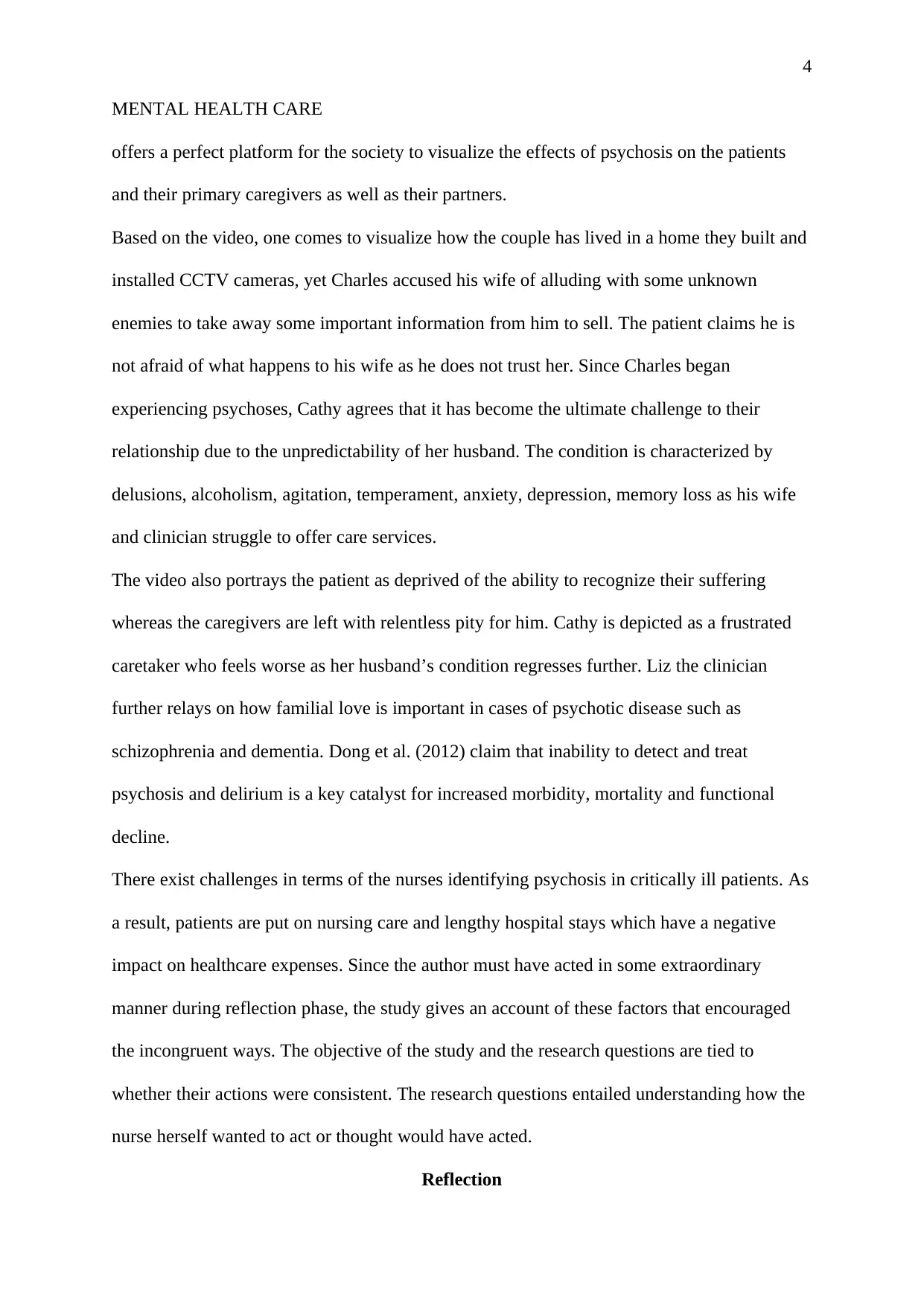
4
MENTAL HEALTH CARE
offers a perfect platform for the society to visualize the effects of psychosis on the patients
and their primary caregivers as well as their partners.
Based on the video, one comes to visualize how the couple has lived in a home they built and
installed CCTV cameras, yet Charles accused his wife of alluding with some unknown
enemies to take away some important information from him to sell. The patient claims he is
not afraid of what happens to his wife as he does not trust her. Since Charles began
experiencing psychoses, Cathy agrees that it has become the ultimate challenge to their
relationship due to the unpredictability of her husband. The condition is characterized by
delusions, alcoholism, agitation, temperament, anxiety, depression, memory loss as his wife
and clinician struggle to offer care services.
The video also portrays the patient as deprived of the ability to recognize their suffering
whereas the caregivers are left with relentless pity for him. Cathy is depicted as a frustrated
caretaker who feels worse as her husband’s condition regresses further. Liz the clinician
further relays on how familial love is important in cases of psychotic disease such as
schizophrenia and dementia. Dong et al. (2012) claim that inability to detect and treat
psychosis and delirium is a key catalyst for increased morbidity, mortality and functional
decline.
There exist challenges in terms of the nurses identifying psychosis in critically ill patients. As
a result, patients are put on nursing care and lengthy hospital stays which have a negative
impact on healthcare expenses. Since the author must have acted in some extraordinary
manner during reflection phase, the study gives an account of these factors that encouraged
the incongruent ways. The objective of the study and the research questions are tied to
whether their actions were consistent. The research questions entailed understanding how the
nurse herself wanted to act or thought would have acted.
Reflection
MENTAL HEALTH CARE
offers a perfect platform for the society to visualize the effects of psychosis on the patients
and their primary caregivers as well as their partners.
Based on the video, one comes to visualize how the couple has lived in a home they built and
installed CCTV cameras, yet Charles accused his wife of alluding with some unknown
enemies to take away some important information from him to sell. The patient claims he is
not afraid of what happens to his wife as he does not trust her. Since Charles began
experiencing psychoses, Cathy agrees that it has become the ultimate challenge to their
relationship due to the unpredictability of her husband. The condition is characterized by
delusions, alcoholism, agitation, temperament, anxiety, depression, memory loss as his wife
and clinician struggle to offer care services.
The video also portrays the patient as deprived of the ability to recognize their suffering
whereas the caregivers are left with relentless pity for him. Cathy is depicted as a frustrated
caretaker who feels worse as her husband’s condition regresses further. Liz the clinician
further relays on how familial love is important in cases of psychotic disease such as
schizophrenia and dementia. Dong et al. (2012) claim that inability to detect and treat
psychosis and delirium is a key catalyst for increased morbidity, mortality and functional
decline.
There exist challenges in terms of the nurses identifying psychosis in critically ill patients. As
a result, patients are put on nursing care and lengthy hospital stays which have a negative
impact on healthcare expenses. Since the author must have acted in some extraordinary
manner during reflection phase, the study gives an account of these factors that encouraged
the incongruent ways. The objective of the study and the research questions are tied to
whether their actions were consistent. The research questions entailed understanding how the
nurse herself wanted to act or thought would have acted.
Reflection
Paraphrase This Document
Need a fresh take? Get an instant paraphrase of this document with our AI Paraphraser
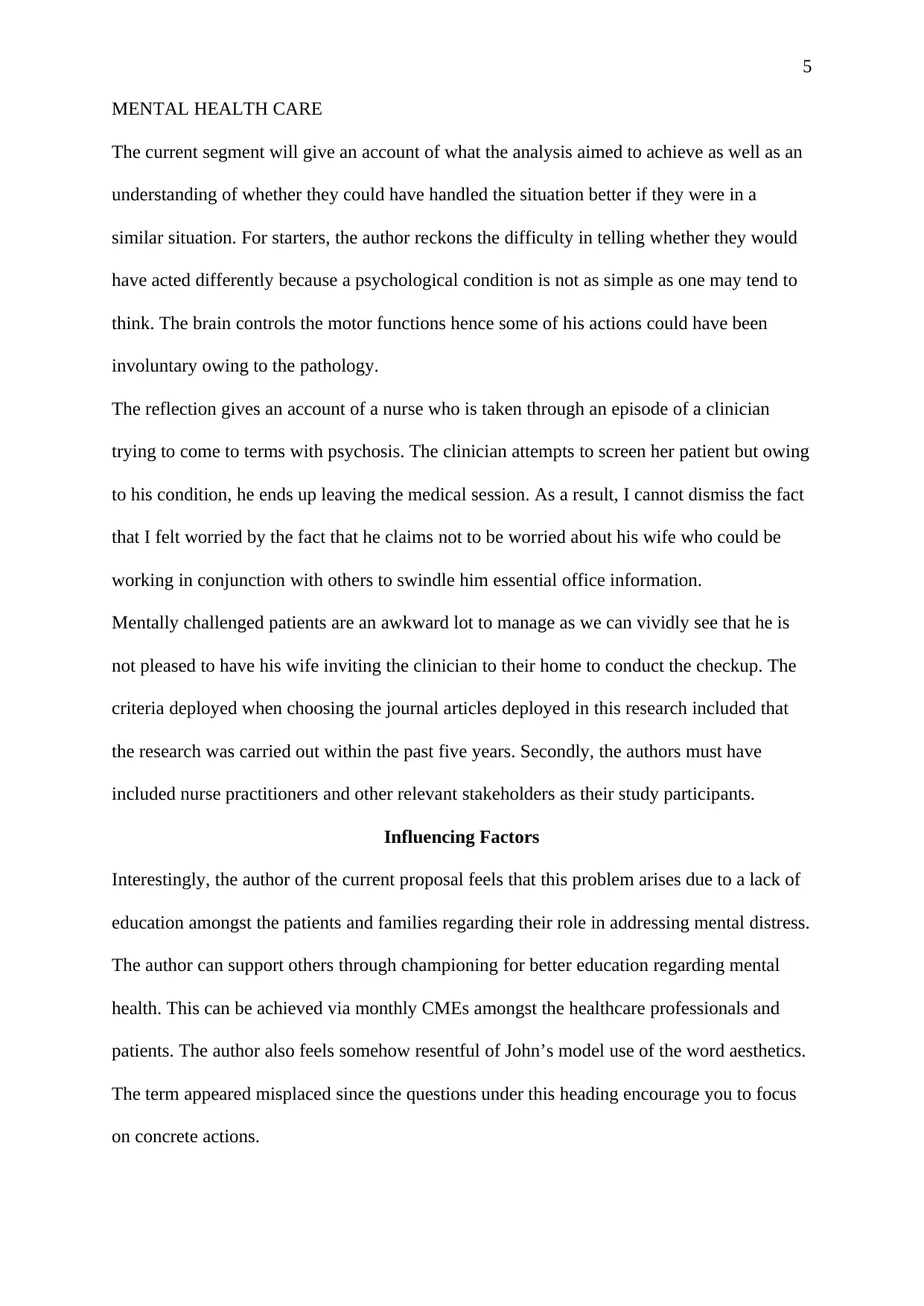
5
MENTAL HEALTH CARE
The current segment will give an account of what the analysis aimed to achieve as well as an
understanding of whether they could have handled the situation better if they were in a
similar situation. For starters, the author reckons the difficulty in telling whether they would
have acted differently because a psychological condition is not as simple as one may tend to
think. The brain controls the motor functions hence some of his actions could have been
involuntary owing to the pathology.
The reflection gives an account of a nurse who is taken through an episode of a clinician
trying to come to terms with psychosis. The clinician attempts to screen her patient but owing
to his condition, he ends up leaving the medical session. As a result, I cannot dismiss the fact
that I felt worried by the fact that he claims not to be worried about his wife who could be
working in conjunction with others to swindle him essential office information.
Mentally challenged patients are an awkward lot to manage as we can vividly see that he is
not pleased to have his wife inviting the clinician to their home to conduct the checkup. The
criteria deployed when choosing the journal articles deployed in this research included that
the research was carried out within the past five years. Secondly, the authors must have
included nurse practitioners and other relevant stakeholders as their study participants.
Influencing Factors
Interestingly, the author of the current proposal feels that this problem arises due to a lack of
education amongst the patients and families regarding their role in addressing mental distress.
The author can support others through championing for better education regarding mental
health. This can be achieved via monthly CMEs amongst the healthcare professionals and
patients. The author also feels somehow resentful of John’s model use of the word aesthetics.
The term appeared misplaced since the questions under this heading encourage you to focus
on concrete actions.
MENTAL HEALTH CARE
The current segment will give an account of what the analysis aimed to achieve as well as an
understanding of whether they could have handled the situation better if they were in a
similar situation. For starters, the author reckons the difficulty in telling whether they would
have acted differently because a psychological condition is not as simple as one may tend to
think. The brain controls the motor functions hence some of his actions could have been
involuntary owing to the pathology.
The reflection gives an account of a nurse who is taken through an episode of a clinician
trying to come to terms with psychosis. The clinician attempts to screen her patient but owing
to his condition, he ends up leaving the medical session. As a result, I cannot dismiss the fact
that I felt worried by the fact that he claims not to be worried about his wife who could be
working in conjunction with others to swindle him essential office information.
Mentally challenged patients are an awkward lot to manage as we can vividly see that he is
not pleased to have his wife inviting the clinician to their home to conduct the checkup. The
criteria deployed when choosing the journal articles deployed in this research included that
the research was carried out within the past five years. Secondly, the authors must have
included nurse practitioners and other relevant stakeholders as their study participants.
Influencing Factors
Interestingly, the author of the current proposal feels that this problem arises due to a lack of
education amongst the patients and families regarding their role in addressing mental distress.
The author can support others through championing for better education regarding mental
health. This can be achieved via monthly CMEs amongst the healthcare professionals and
patients. The author also feels somehow resentful of John’s model use of the word aesthetics.
The term appeared misplaced since the questions under this heading encourage you to focus
on concrete actions.
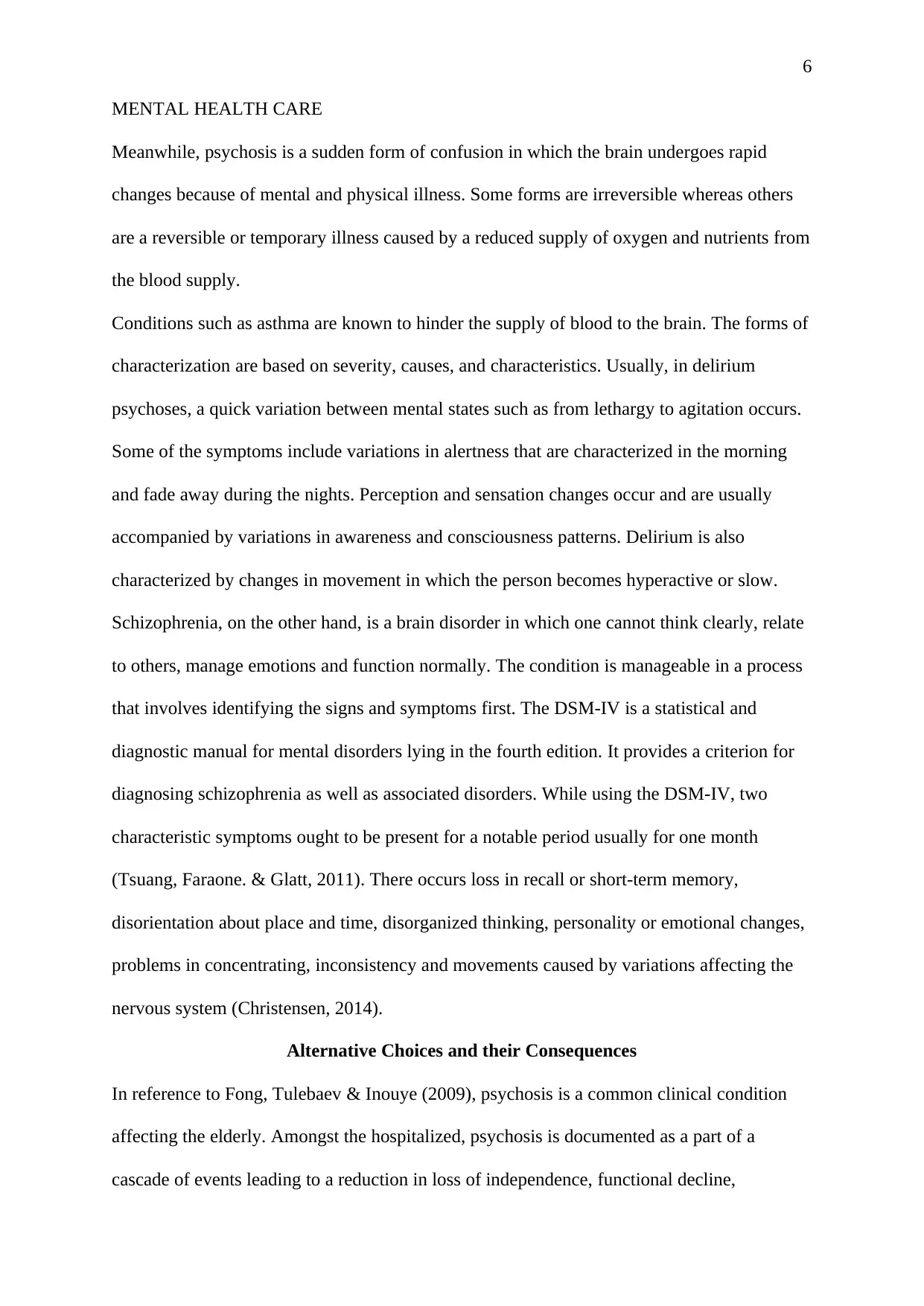
6
MENTAL HEALTH CARE
Meanwhile, psychosis is a sudden form of confusion in which the brain undergoes rapid
changes because of mental and physical illness. Some forms are irreversible whereas others
are a reversible or temporary illness caused by a reduced supply of oxygen and nutrients from
the blood supply.
Conditions such as asthma are known to hinder the supply of blood to the brain. The forms of
characterization are based on severity, causes, and characteristics. Usually, in delirium
psychoses, a quick variation between mental states such as from lethargy to agitation occurs.
Some of the symptoms include variations in alertness that are characterized in the morning
and fade away during the nights. Perception and sensation changes occur and are usually
accompanied by variations in awareness and consciousness patterns. Delirium is also
characterized by changes in movement in which the person becomes hyperactive or slow.
Schizophrenia, on the other hand, is a brain disorder in which one cannot think clearly, relate
to others, manage emotions and function normally. The condition is manageable in a process
that involves identifying the signs and symptoms first. The DSM-IV is a statistical and
diagnostic manual for mental disorders lying in the fourth edition. It provides a criterion for
diagnosing schizophrenia as well as associated disorders. While using the DSM-IV, two
characteristic symptoms ought to be present for a notable period usually for one month
(Tsuang, Faraone. & Glatt, 2011). There occurs loss in recall or short-term memory,
disorientation about place and time, disorganized thinking, personality or emotional changes,
problems in concentrating, inconsistency and movements caused by variations affecting the
nervous system (Christensen, 2014).
Alternative Choices and their Consequences
In reference to Fong, Tulebaev & Inouye (2009), psychosis is a common clinical condition
affecting the elderly. Amongst the hospitalized, psychosis is documented as a part of a
cascade of events leading to a reduction in loss of independence, functional decline,
MENTAL HEALTH CARE
Meanwhile, psychosis is a sudden form of confusion in which the brain undergoes rapid
changes because of mental and physical illness. Some forms are irreversible whereas others
are a reversible or temporary illness caused by a reduced supply of oxygen and nutrients from
the blood supply.
Conditions such as asthma are known to hinder the supply of blood to the brain. The forms of
characterization are based on severity, causes, and characteristics. Usually, in delirium
psychoses, a quick variation between mental states such as from lethargy to agitation occurs.
Some of the symptoms include variations in alertness that are characterized in the morning
and fade away during the nights. Perception and sensation changes occur and are usually
accompanied by variations in awareness and consciousness patterns. Delirium is also
characterized by changes in movement in which the person becomes hyperactive or slow.
Schizophrenia, on the other hand, is a brain disorder in which one cannot think clearly, relate
to others, manage emotions and function normally. The condition is manageable in a process
that involves identifying the signs and symptoms first. The DSM-IV is a statistical and
diagnostic manual for mental disorders lying in the fourth edition. It provides a criterion for
diagnosing schizophrenia as well as associated disorders. While using the DSM-IV, two
characteristic symptoms ought to be present for a notable period usually for one month
(Tsuang, Faraone. & Glatt, 2011). There occurs loss in recall or short-term memory,
disorientation about place and time, disorganized thinking, personality or emotional changes,
problems in concentrating, inconsistency and movements caused by variations affecting the
nervous system (Christensen, 2014).
Alternative Choices and their Consequences
In reference to Fong, Tulebaev & Inouye (2009), psychosis is a common clinical condition
affecting the elderly. Amongst the hospitalized, psychosis is documented as a part of a
cascade of events leading to a reduction in loss of independence, functional decline,
⊘ This is a preview!⊘
Do you want full access?
Subscribe today to unlock all pages.

Trusted by 1+ million students worldwide
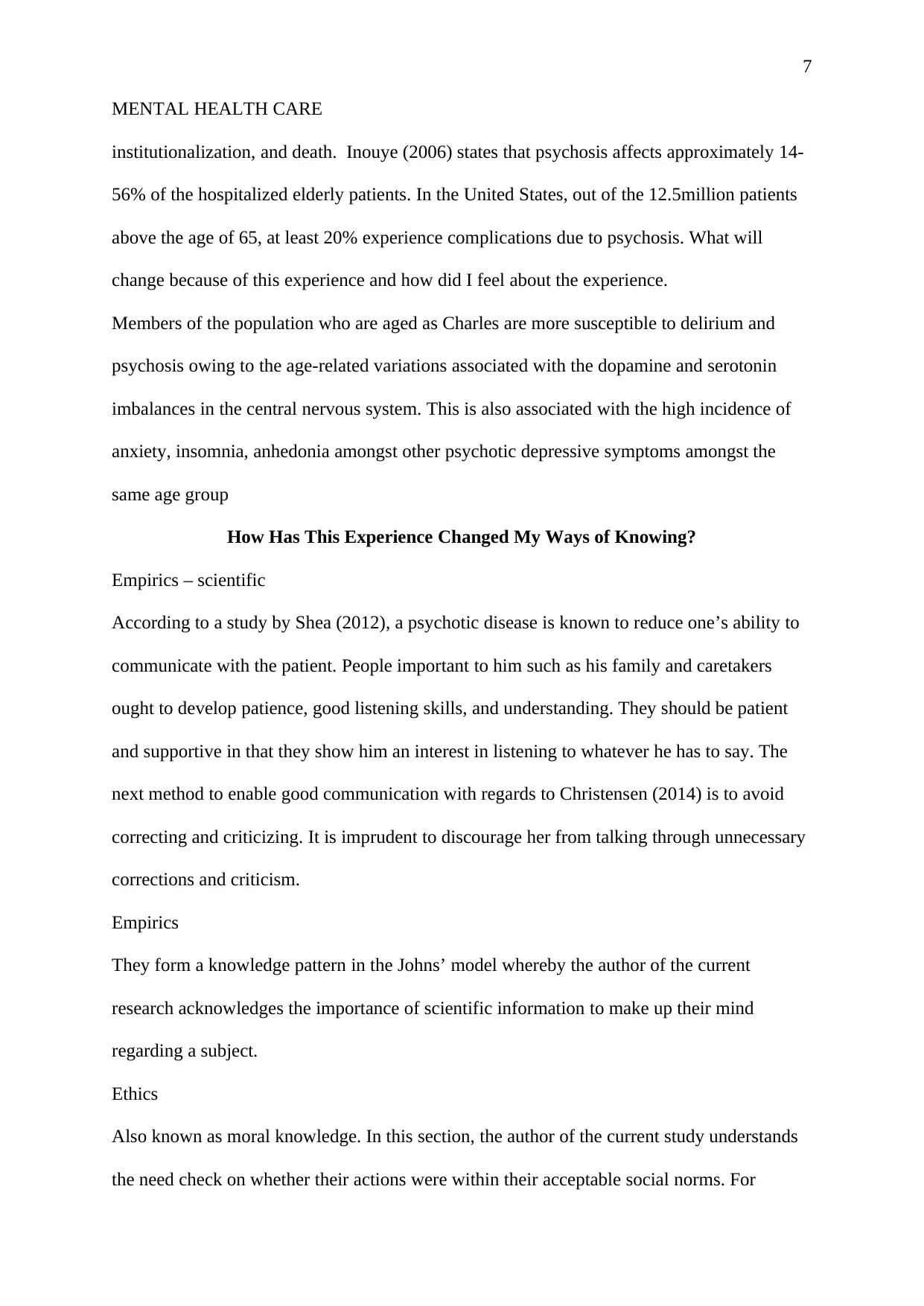
7
MENTAL HEALTH CARE
institutionalization, and death. Inouye (2006) states that psychosis affects approximately 14-
56% of the hospitalized elderly patients. In the United States, out of the 12.5million patients
above the age of 65, at least 20% experience complications due to psychosis. What will
change because of this experience and how did I feel about the experience.
Members of the population who are aged as Charles are more susceptible to delirium and
psychosis owing to the age-related variations associated with the dopamine and serotonin
imbalances in the central nervous system. This is also associated with the high incidence of
anxiety, insomnia, anhedonia amongst other psychotic depressive symptoms amongst the
same age group
How Has This Experience Changed My Ways of Knowing?
Empirics – scientific
According to a study by Shea (2012), a psychotic disease is known to reduce one’s ability to
communicate with the patient. People important to him such as his family and caretakers
ought to develop patience, good listening skills, and understanding. They should be patient
and supportive in that they show him an interest in listening to whatever he has to say. The
next method to enable good communication with regards to Christensen (2014) is to avoid
correcting and criticizing. It is imprudent to discourage her from talking through unnecessary
corrections and criticism.
Empirics
They form a knowledge pattern in the Johns’ model whereby the author of the current
research acknowledges the importance of scientific information to make up their mind
regarding a subject.
Ethics
Also known as moral knowledge. In this section, the author of the current study understands
the need check on whether their actions were within their acceptable social norms. For
MENTAL HEALTH CARE
institutionalization, and death. Inouye (2006) states that psychosis affects approximately 14-
56% of the hospitalized elderly patients. In the United States, out of the 12.5million patients
above the age of 65, at least 20% experience complications due to psychosis. What will
change because of this experience and how did I feel about the experience.
Members of the population who are aged as Charles are more susceptible to delirium and
psychosis owing to the age-related variations associated with the dopamine and serotonin
imbalances in the central nervous system. This is also associated with the high incidence of
anxiety, insomnia, anhedonia amongst other psychotic depressive symptoms amongst the
same age group
How Has This Experience Changed My Ways of Knowing?
Empirics – scientific
According to a study by Shea (2012), a psychotic disease is known to reduce one’s ability to
communicate with the patient. People important to him such as his family and caretakers
ought to develop patience, good listening skills, and understanding. They should be patient
and supportive in that they show him an interest in listening to whatever he has to say. The
next method to enable good communication with regards to Christensen (2014) is to avoid
correcting and criticizing. It is imprudent to discourage her from talking through unnecessary
corrections and criticism.
Empirics
They form a knowledge pattern in the Johns’ model whereby the author of the current
research acknowledges the importance of scientific information to make up their mind
regarding a subject.
Ethics
Also known as moral knowledge. In this section, the author of the current study understands
the need check on whether their actions were within their acceptable social norms. For
Paraphrase This Document
Need a fresh take? Get an instant paraphrase of this document with our AI Paraphraser
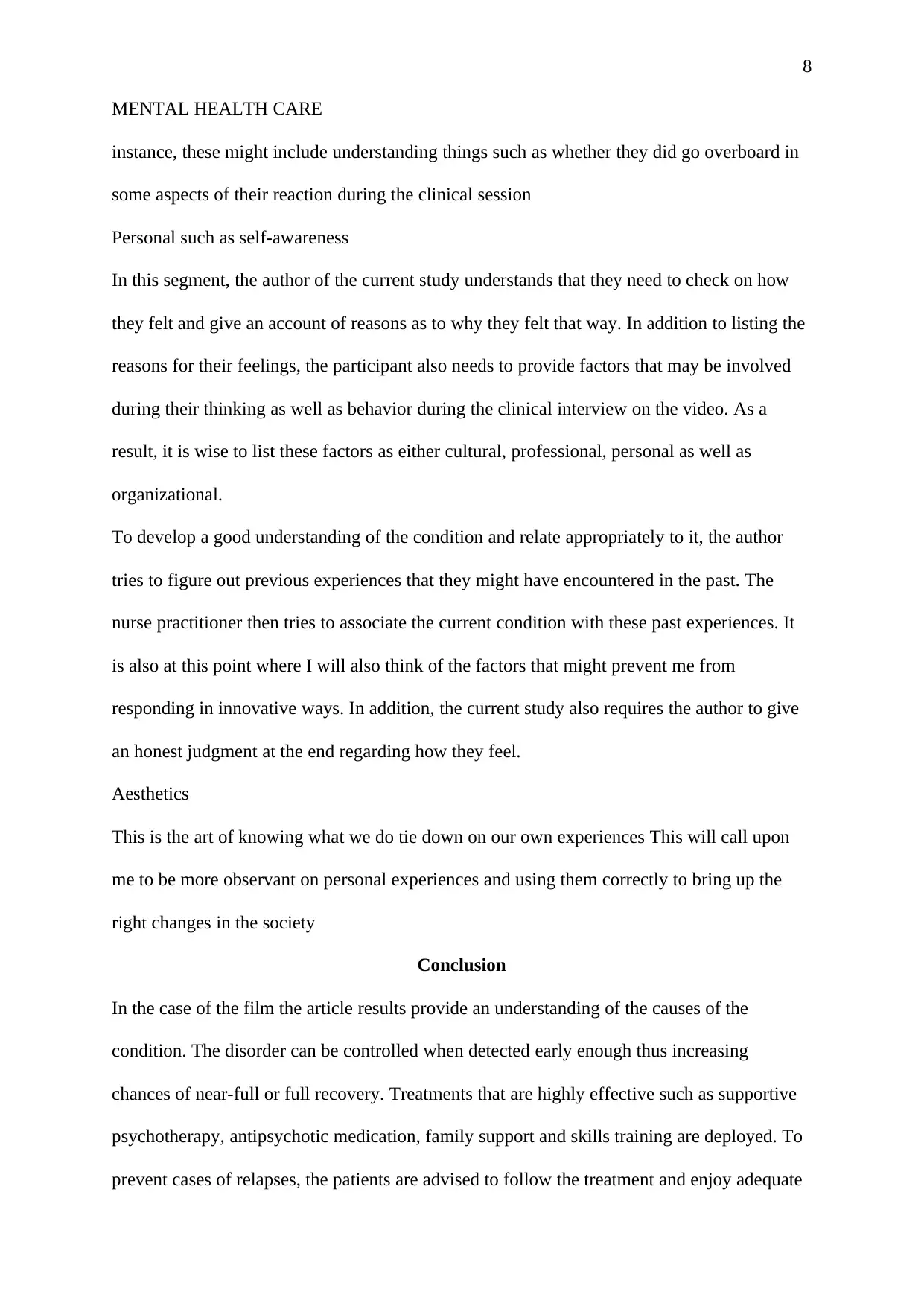
8
MENTAL HEALTH CARE
instance, these might include understanding things such as whether they did go overboard in
some aspects of their reaction during the clinical session
Personal such as self-awareness
In this segment, the author of the current study understands that they need to check on how
they felt and give an account of reasons as to why they felt that way. In addition to listing the
reasons for their feelings, the participant also needs to provide factors that may be involved
during their thinking as well as behavior during the clinical interview on the video. As a
result, it is wise to list these factors as either cultural, professional, personal as well as
organizational.
To develop a good understanding of the condition and relate appropriately to it, the author
tries to figure out previous experiences that they might have encountered in the past. The
nurse practitioner then tries to associate the current condition with these past experiences. It
is also at this point where I will also think of the factors that might prevent me from
responding in innovative ways. In addition, the current study also requires the author to give
an honest judgment at the end regarding how they feel.
Aesthetics
This is the art of knowing what we do tie down on our own experiences This will call upon
me to be more observant on personal experiences and using them correctly to bring up the
right changes in the society
Conclusion
In the case of the film the article results provide an understanding of the causes of the
condition. The disorder can be controlled when detected early enough thus increasing
chances of near-full or full recovery. Treatments that are highly effective such as supportive
psychotherapy, antipsychotic medication, family support and skills training are deployed. To
prevent cases of relapses, the patients are advised to follow the treatment and enjoy adequate
MENTAL HEALTH CARE
instance, these might include understanding things such as whether they did go overboard in
some aspects of their reaction during the clinical session
Personal such as self-awareness
In this segment, the author of the current study understands that they need to check on how
they felt and give an account of reasons as to why they felt that way. In addition to listing the
reasons for their feelings, the participant also needs to provide factors that may be involved
during their thinking as well as behavior during the clinical interview on the video. As a
result, it is wise to list these factors as either cultural, professional, personal as well as
organizational.
To develop a good understanding of the condition and relate appropriately to it, the author
tries to figure out previous experiences that they might have encountered in the past. The
nurse practitioner then tries to associate the current condition with these past experiences. It
is also at this point where I will also think of the factors that might prevent me from
responding in innovative ways. In addition, the current study also requires the author to give
an honest judgment at the end regarding how they feel.
Aesthetics
This is the art of knowing what we do tie down on our own experiences This will call upon
me to be more observant on personal experiences and using them correctly to bring up the
right changes in the society
Conclusion
In the case of the film the article results provide an understanding of the causes of the
condition. The disorder can be controlled when detected early enough thus increasing
chances of near-full or full recovery. Treatments that are highly effective such as supportive
psychotherapy, antipsychotic medication, family support and skills training are deployed. To
prevent cases of relapses, the patients are advised to follow the treatment and enjoy adequate
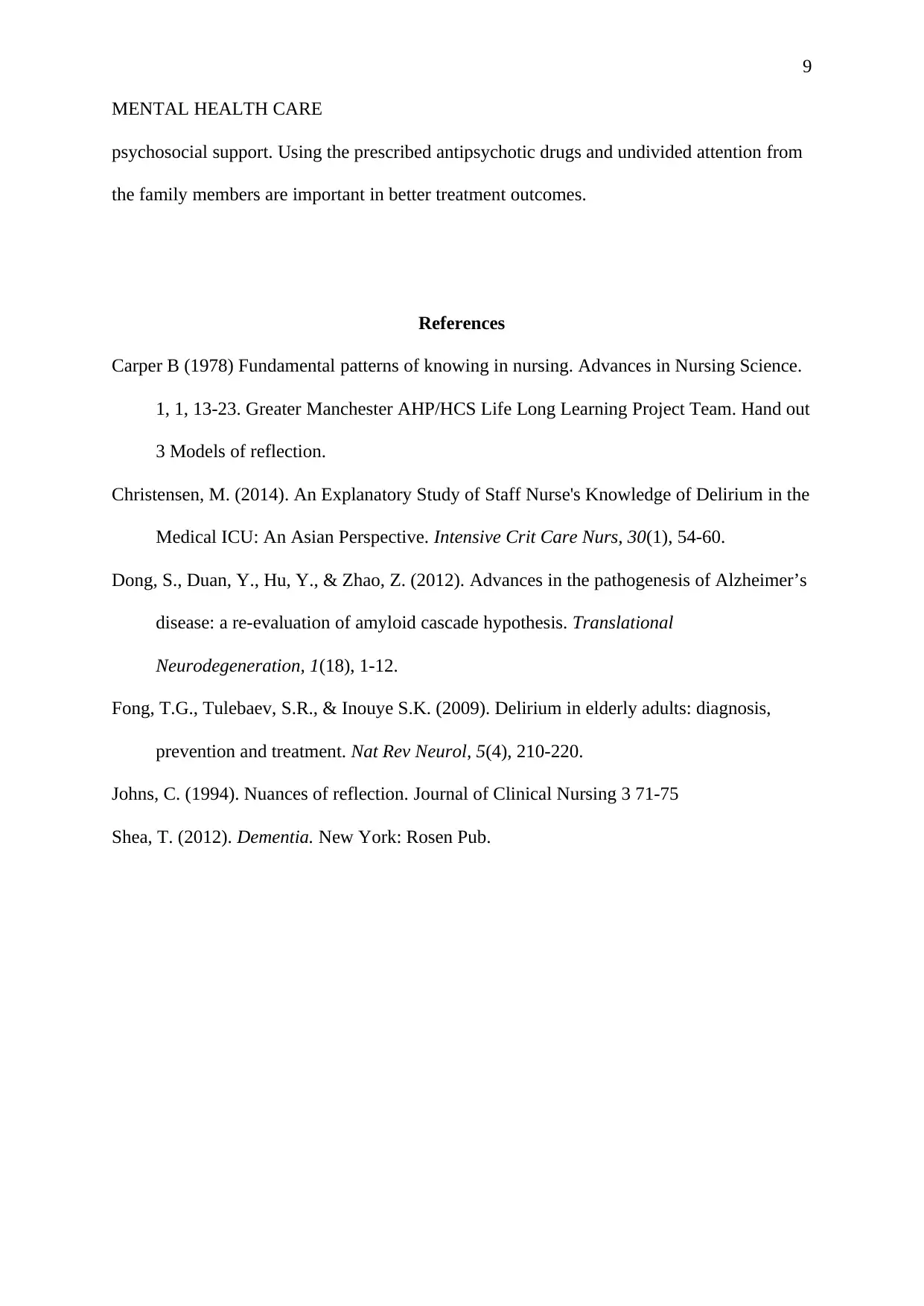
9
MENTAL HEALTH CARE
psychosocial support. Using the prescribed antipsychotic drugs and undivided attention from
the family members are important in better treatment outcomes.
References
Carper B (1978) Fundamental patterns of knowing in nursing. Advances in Nursing Science.
1, 1, 13-23. Greater Manchester AHP/HCS Life Long Learning Project Team. Hand out
3 Models of reflection.
Christensen, M. (2014). An Explanatory Study of Staff Nurse's Knowledge of Delirium in the
Medical ICU: An Asian Perspective. Intensive Crit Care Nurs, 30(1), 54-60.
Dong, S., Duan, Y., Hu, Y., & Zhao, Z. (2012). Advances in the pathogenesis of Alzheimer’s
disease: a re-evaluation of amyloid cascade hypothesis. Translational
Neurodegeneration, 1(18), 1-12.
Fong, T.G., Tulebaev, S.R., & Inouye S.K. (2009). Delirium in elderly adults: diagnosis,
prevention and treatment. Nat Rev Neurol, 5(4), 210-220.
Johns, C. (1994). Nuances of reflection. Journal of Clinical Nursing 3 71-75
Shea, T. (2012). Dementia. New York: Rosen Pub.
MENTAL HEALTH CARE
psychosocial support. Using the prescribed antipsychotic drugs and undivided attention from
the family members are important in better treatment outcomes.
References
Carper B (1978) Fundamental patterns of knowing in nursing. Advances in Nursing Science.
1, 1, 13-23. Greater Manchester AHP/HCS Life Long Learning Project Team. Hand out
3 Models of reflection.
Christensen, M. (2014). An Explanatory Study of Staff Nurse's Knowledge of Delirium in the
Medical ICU: An Asian Perspective. Intensive Crit Care Nurs, 30(1), 54-60.
Dong, S., Duan, Y., Hu, Y., & Zhao, Z. (2012). Advances in the pathogenesis of Alzheimer’s
disease: a re-evaluation of amyloid cascade hypothesis. Translational
Neurodegeneration, 1(18), 1-12.
Fong, T.G., Tulebaev, S.R., & Inouye S.K. (2009). Delirium in elderly adults: diagnosis,
prevention and treatment. Nat Rev Neurol, 5(4), 210-220.
Johns, C. (1994). Nuances of reflection. Journal of Clinical Nursing 3 71-75
Shea, T. (2012). Dementia. New York: Rosen Pub.
⊘ This is a preview!⊘
Do you want full access?
Subscribe today to unlock all pages.

Trusted by 1+ million students worldwide
1 out of 9
Related Documents
Your All-in-One AI-Powered Toolkit for Academic Success.
+13062052269
info@desklib.com
Available 24*7 on WhatsApp / Email
![[object Object]](/_next/static/media/star-bottom.7253800d.svg)
Unlock your academic potential
Copyright © 2020–2025 A2Z Services. All Rights Reserved. Developed and managed by ZUCOL.





